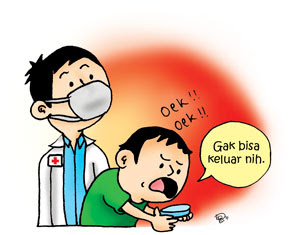Herniated Nucleus Pulposus
Intervertebral Discs are the cartilage plates that form a cushion between the vertebral bodies. Hard and fibrous material is combined in one capsule. Such as ball bearings in the middle of the disc called the nucleus pulposus. Herniated nucleus pulposus is a rupture of the nucleus pulposus.
Herniated nucleus pulposus into the vertebral bodies can be above or below it, can also directly into the vertebral canal.
Pain can occur in any part such as cervical spine, thoracic (rarely) or lumbar. Clinical manifestations depend on the location, speed of development (acute or chronic) and the effect on surrounding structures. Lower back pain is severe, chronic and recurring (relapse).
Diagnostic Examination
1. Spinal RO: Shows the degenerative changes in the spine
2. MRI: to localize even small disc protrusion, especially for lumbar spinal disease.
3. CT Scan and Myelogram if the clinical and pathological symptoms are not visible on MRI
4. Electromyography (EMG): to localize the specific spinal nerve roots are exposed.
Assessment Nursing Care Plan for HNP Herniated Nucleus Pulposus
1. Anamnesa
The main complaint, history of present treatments, medical history past, family health history.
2. Physical examination
Assessment of the patient's problem consists of onset, location and spread of pain, paresthesias, limited mobility and limited function of the neck, shoulders and upper extremities.
Assessment in the area include palpation of the cervical spine which aims to assess muscle tone and rigidity.
3. Examination Support
Diagnosis Nursing Care Plan for HNP Herniated Nucleus Pulposus
1. Acute Pain
2. Impaired physical mobility
3. Anxiety
4. Knowledge deficient
Intervention Nursing Care Plan for HNP Herniated Nucleus Pulposus
1. Acute pain related to nerve compression, muscle spasm
a. Assess complaints of pain, location, duration of attacks, precipitating factors / which aggravate. Set scale of 0-10
b. Maintain bed rest, semi-Fowler position to the spinal bones, hips and knees in a state of flexion, supine position
c. Use logroll (board) during a change of position
d. Auxiliary mounting brace / corset
e. Limit your activity during the acute phase according to the needs
f. Teach relaxation techniques
g. Collaboration: analgesics, traction, physiotherapy
2. Impaired physical mobility related to pain, muscle spasms, and damage neuromuskulus restrictive therapy
a. Give / aids patients to perform passive range of motion exercises and active
b. Assist patients in ambulation activity progressively
c. Provide good skin care, massage point pressure after rehap change of position. Check the state of the skin under the brace with a specific time period.
d. Note the emotional responses / behaviors in immobilizing
e. Demonstrate the use of auxiliary equipment such as a cane.
f. Collaboration: analgesic
3. Anxiety related to ineffective individual coping
a. Assess the patient's anxiety level
b. Provide accurate information
c. Give the patient the opportunity to reveal problems such as the possibility of paralysis, the effect on sexual function, changes in roles and responsibilities.
d. Review of secondary problems that may impede the desire to heal and may hinder the healing process.
e. Involve the family
4. Knowledge deficient related to the lack of information about the condition, prognosis
a. Explain the process of disease and prognosis, and restrictions on activities
b. Give information about your own body mechanics to stand, lift and use the shoes backer
c. Discuss about treatment and side effects.
d. Suggest to use the board / mat is strong, a small pillow under your neck a little flat, bed side with knees flexed, avoid the tummy.
e. Avoid the use of heaters in a long time
f. Give information about the signs that need attention such as puncture pain, loss of sensation / ability to walk.
Read More..
Intervertebral Discs are the cartilage plates that form a cushion between the vertebral bodies. Hard and fibrous material is combined in one capsule. Such as ball bearings in the middle of the disc called the nucleus pulposus. Herniated nucleus pulposus is a rupture of the nucleus pulposus.
Herniated nucleus pulposus into the vertebral bodies can be above or below it, can also directly into the vertebral canal.
Pain can occur in any part such as cervical spine, thoracic (rarely) or lumbar. Clinical manifestations depend on the location, speed of development (acute or chronic) and the effect on surrounding structures. Lower back pain is severe, chronic and recurring (relapse).
Diagnostic Examination
1. Spinal RO: Shows the degenerative changes in the spine
2. MRI: to localize even small disc protrusion, especially for lumbar spinal disease.
3. CT Scan and Myelogram if the clinical and pathological symptoms are not visible on MRI
4. Electromyography (EMG): to localize the specific spinal nerve roots are exposed.
Assessment Nursing Care Plan for HNP Herniated Nucleus Pulposus
1. Anamnesa
The main complaint, history of present treatments, medical history past, family health history.
2. Physical examination
Assessment of the patient's problem consists of onset, location and spread of pain, paresthesias, limited mobility and limited function of the neck, shoulders and upper extremities.
Assessment in the area include palpation of the cervical spine which aims to assess muscle tone and rigidity.
3. Examination Support
Diagnosis Nursing Care Plan for HNP Herniated Nucleus Pulposus
1. Acute Pain
2. Impaired physical mobility
3. Anxiety
4. Knowledge deficient
Intervention Nursing Care Plan for HNP Herniated Nucleus Pulposus
1. Acute pain related to nerve compression, muscle spasm
a. Assess complaints of pain, location, duration of attacks, precipitating factors / which aggravate. Set scale of 0-10
b. Maintain bed rest, semi-Fowler position to the spinal bones, hips and knees in a state of flexion, supine position
c. Use logroll (board) during a change of position
d. Auxiliary mounting brace / corset
e. Limit your activity during the acute phase according to the needs
f. Teach relaxation techniques
g. Collaboration: analgesics, traction, physiotherapy
2. Impaired physical mobility related to pain, muscle spasms, and damage neuromuskulus restrictive therapy
a. Give / aids patients to perform passive range of motion exercises and active
b. Assist patients in ambulation activity progressively
c. Provide good skin care, massage point pressure after rehap change of position. Check the state of the skin under the brace with a specific time period.
d. Note the emotional responses / behaviors in immobilizing
e. Demonstrate the use of auxiliary equipment such as a cane.
f. Collaboration: analgesic
3. Anxiety related to ineffective individual coping
a. Assess the patient's anxiety level
b. Provide accurate information
c. Give the patient the opportunity to reveal problems such as the possibility of paralysis, the effect on sexual function, changes in roles and responsibilities.
d. Review of secondary problems that may impede the desire to heal and may hinder the healing process.
e. Involve the family
4. Knowledge deficient related to the lack of information about the condition, prognosis
a. Explain the process of disease and prognosis, and restrictions on activities
b. Give information about your own body mechanics to stand, lift and use the shoes backer
c. Discuss about treatment and side effects.
d. Suggest to use the board / mat is strong, a small pillow under your neck a little flat, bed side with knees flexed, avoid the tummy.
e. Avoid the use of heaters in a long time
f. Give information about the signs that need attention such as puncture pain, loss of sensation / ability to walk.





